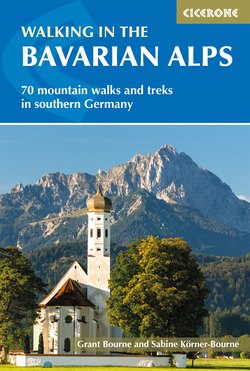Читать книгу Walking in the Bavarian Alps - Grant Bourne - Страница 9
На сайте Литреса книга снята с продажи.
ОглавлениеPREFACE
As far as most non-German mountain walkers are concerned the Bavarian Alps lie very much in the shadow of the Austrian and Swiss Alps. This is a shame, for what this border region lacks in terms of the comparative height and extent of its mountains is more than compensated for by the diversity of its landscape and cultural attractions.
This fourth edition of the guidebook hopes to bring that diversity to the attention of more outdoor enthusiasts. Moving from west to east, the guidebook starts with a look at the Allgäu, a region renowned for its wildflowers, tranquil alpine pastures and the impossibly steep grass slopes that characterise many of its well-known peaks. Moving further east, mountain trails lead past famous castles such as Neuschwanstein, which seems to have materialised from the pages of a storybook. In the vicinity of Garmisch-Partenkirchen you can sunbathe on the grassy summit of the Wank while enjoying a fantastic bird’s-eye view over the world-famous alpine resort. At the foot of the Zugspitze, Germany’s highest mountain, a trail skirts the shores of the beautiful Eibsee, a pristine lake surpassed in beauty only by the Königssee, visited in the final section of the guidebook. Here, in the Berchtesgaden Alps, trails in the shadow of the mighty Watzmann massif lead you through a landscape of Wagnerian grandeur.
There is, of course, much more to discover along these mountain trails. Upland moors, an ice cave, remote other-worldly karst landscapes like the Steinernes Meer and wild mountain gorges such as the Höllentalklamm, Leutaschklamm and Partnachklamm are just a few of the highlights. But for those who really want to discover the full beauty of the mountains the biggest highlight will be one of the multi-day tours. Perhaps you will experience the famed alpenglow while staying at a remote hut like Kärlinger Haus (Walk 68), or spot a rare bearded vulture on the two-day hike to Leutasch in Austria (Walk 25). Above all, after a few days without the distractions and stress of urban living, you might achieve that sense of calm that only a longer sojourn in the mountains can bring.
Many of the base towns mentioned offer free travel on buses within a designated region. This makes it even easier for visitors to the Bavarian Alps to leave their cars behind and let somebody else do the driving. Not only can the start of many of the walks described be reached for free, but you also have the satisfaction of knowing you are helping the environment at the same time.
Although every attempt has been made to ensure the accuracy of the information given on the routes, floods and other natural events can erase landmarks, make it necessary to modify routes, or occasionally render a section of track unwalkable. However, a look at an up-to-date map, or a chat with hut wardens and other hikers on the spot, will ensure that such inconveniences are kept to a minimum.
Grant Bourne and Sabine Körner-Bourne, 2018
Meadow at Schönau (near Königssee, Berchtesgaden Alps)
